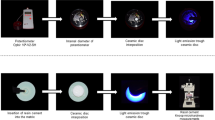Abstract
The aim of this study was to evaluate in vitro the Knoop hardness in the top and bottom of composite photo activated by different methods when different mold materials were used. Z250 (3M ESPE) and XL2500 halogen unit (3M ESPE) were used. For hardness test, conical restorations were made in extracted bovine incisors (tooth mold) and also metal mold (approximately 2 mm top diameter × 1.5 mm bottom diameter × 2 mm in height). Different photoactivation methods were tested: high-intensity continuous (HIC), low-intensity continuous (LIC), soft-start, or pulse-delay (PD), with constant radiant exposure. Knoop readings were performed on top and bottom restoration surfaces. Data were submitted to two-way ANOVA and Tukey’s test (p = 0.05). On the top, regardless of the mold used, no significant difference in the Knoop hardness (Knoop hardness number, in kilograms–force per square millimeter) was observed between the photoactivation methods. On the bottom surface, the photoactivation method HIC shows higher means of hardness than LIC when tooth and metal were used. Significant differences of hardness on the top and in the bottom were detected between tooth and metal. The photoactivation method LIC and the material mold can interfere in the hardness values of composite restorations.

Similar content being viewed by others
References
Feilzer AJ, Dooren LH, de Gee AJ, Davidson CL (1995) Influence of light intensity on polymerization shrinkage and integrity of restoration–cavity interface. Eur J Oral Sci 103:322–326
Feilzer AJ, de Gee AJ, Davidson CL (1990) Quantitative determination of stress reduction by flow in composite restorations. Dent Mater 6:167–171
Brandt WC, de Moraes RR, Correr-Sobrinho L, Sinhoreti MA, Consani S (2008) Effect of different photo-activation methods on push out force, hardness and cross-link density of resin composite restorations. Dent Mater 24:846–850
Blažić L, Pantelić D, Savić-Šević S, Murić B, Belić I, Panić B (2011) Modulated photoactivation of composite restoration: measurement of cuspal movement using holographic interferometry. Lasers Med Sci 26(2):179–186
Kinomoto Y, Torii M, Takeshige F, Ebisu S (1999) Comparison of polymerization contraction stress between self- and light-curing composites. J Dent 27:383–389
Lutz F, Krejci I, Barbakow F (1991) Quality and durability of marginal adaptation in bonded composite restorations. Dent Mater 7:107–113
Alonso RC, Cunha LG, Correr GM, Cunha Brandt W, Correr-Sobrinho L, Sinhoreti MA (2006) Relationship between bond strength and marginal and internal adaptation of composite restorations photocured by different methods. Acta Odontol Scand 64:306–313
Cunha LG, Alonso RC, Correr GM, Brandt WC, Correr-Sobrinho L, Sinhoreti MA (2008) Effect of different photoactivation methods on the bond strength of composite resin restorations by push-out test. Quintessence Int 39:243–249
Lu H, Stansbury JW, Bowman CN (2005) Impact of curing protocol on conversion and shrinkage stress. J Dent Res 84:822–826
Ferracane JL (1985) Correlation between hardness and degree conversion during the setting reaction of unfilled dental restorative resins. Dent Mater 1:11–14
Brandt WC, Cardoso L, Moraes RR, Correr-Sobrinho L, Sinhoreti MAC (2008) Influence of light-curing units on the flexural strength and flexural modulus of different resin composites. Braz J Oral Sci 7:1555–1558
Brandt WC, Schneider LF, Frollini E, Correr-Sobrinho L, Sinhoreti MA (2010) Effect of different photo-initiators and light curing units on degree of conversion of composites. Braz Oral Res 24:263–270
Tielemans M, Compere P, Geerts SO, Lamy M, Limme M, De Moor RJ, Delmé KI, Bertrand MF, Rompen E, Nammour S (2009) Comparison of microleakages of photo-cured composites using three different light sources: halogen lamp, LED and argon laser: an in vitro study. Lazers Med Sci 24:1–5
Rode KM, de Freitas PM, Lloret PR, Powell LG, Turbino ML (2009) Micro-hardness evaluation of a micro-hybrid composite resin light cured with halogen light, light-emitting diode and argon ion laser. Lasers Med Sci 24:87–92
Halvorson RH, Erickson RL, Davidson CL (2002) Energy dependent polymerization of resin-based composite. Dent Mater 18:463–469
Watts DC (2005) Reaction kinetics and mechanics in photo-polymerised networks. Dent Mater 21:27–35
Rueggeberg F (1999) Contemporary issues in photocuring. Comp Cont Educ Dent Suppl 1999:S4–S15
Lovell LG, Newman SM, Donaldson MM, Bowman CN (2003) The effect of light intensity on double bond conversion and flexural strength of a model, unfilled dental resin. Dent Mater 19:458–465
Souza-Junior EJ, Prieto LT, Soares GP, Dias CT, Aquiar FH, Paulillo LA (2012) The effect of curing light and chemical catalyst on the degree of conversion of two dual cured resin luting cements. Lazers Med Sci 27:145–151
Author information
Authors and Affiliations
Corresponding author
Rights and permissions
About this article
Cite this article
Brandt, W.C., Silva-Concilio, L.R., Neves, A.C.C. et al. Influence of photoactivation method and mold for restoration on the Knoop hardness of resin composite restorations. Lasers Med Sci 28, 1227–1231 (2013). https://doi.org/10.1007/s10103-012-1184-2
Received:
Accepted:
Published:
Issue Date:
DOI: https://doi.org/10.1007/s10103-012-1184-2




